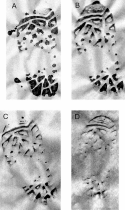Because of the wear, I'm guessing? For example, if someone is a heel walker, or has a turned in foot the wear pattern of the shoe/sole (and hence the print) would reflect this?
That would make sense to me except I'm not sure he wore his shoes to this crime scene. I was thinking he wore everything new in order to put further distance between him and the scene. In this case, I'd think there would be no discernible wear pattern. The dickies tag found in Pullman has bothered me - I have always speculated it might be for a coverall. I would think shoes would be new too, and he wouldn't choose vans. Too slippery.
I have always thought there is a chance that print could belong to someone else. I think I remember seeing that Xana and others in the house owned Vans. Did Ethan? What if it belonged to someone who was called to the home that morning? There are a lot of questions.
All speculation/MOO
Not just because of wear.
Your foot exerts pressure against gravity. When there is a liquid on the bottom of your shoe or foot, that liquid is like sticking your foot onto an ink pad. Think how an ink pad works (especially when used ineptly by someone like me). The idea is that you should strike the paper with the stamp with equal force across the stamp (I never manage it).
Your foot does NOT try to strike equally. It tries very hard to do the opposite. One's heel usually strikes first (so blood on the bottom is going to be stronger in that first print, on the heel; then the foot plants the rest of itself (some people pronate, some don't, some have a high arch, etc) but where your arch is? It's like that place on the stamp where you didn't press hard enough.
So each successive footprint reveals something about the mechanics of the foot. The arch should be quite visible in the earlier, bloodier footprints. They used both luminol and Amido black. We don't know if they saw any footprints without the luminol, but since he apparently stepped in a pool of blood, I'm guessing they did. So first there's a bloody outline of the sole (but the arch area is hardly making an impression). Lastly, we use the fall of our foot and then our toes (in my case, mostly only my big toe, which is a known situation with people who have my toe pattern).
It will look under close analysis much more like a person walking across sand. People with long, strong toes (runners have stronger toes than I do) will have a stronger "stamp" in the toe box than someone like me. I pronate a lot on my left foot and that would be observable in a new print (me wearing shoes), a luminol print and an Amido black print, each with similar but slowly disappearing information. We're probably talking about analyzing how many microns of blood are layered in the print. Then, of course, you want to compare it to shoes worn by the suspect.
It's only part of the picture, but the speed at which the person was moving, their weight, etc as well as the action pattern of their foot are things that MUST match the suspect. If they didn't, the Defense would be all over it. Obviously, what they have so far would show sex, height, weight of the perp (and probably a few other foot characteristics, as mentioned). They do not identify him - but they decrease the numbers of an already very small group of people who had opportunity, were in the area, and were inside the house. Kohberger DNA, Kohberger size shoes, Kohberger width foot, Kohberger so tall, and even just one other detail - strong heel strike?? - would help the State.
This is a long article, but it does (near the beginning) point out how rapidly new shoes take on the traits of the gait/foot, even without stepping into a fluid to help with the analysis. Finding the actual shoes would be great, but the shoe print is the next best thing - and now, they have Kohberger's actual shoes to compare. Such analysis can also show the specific movements of a person at a crime scene (if he had blood on his feet upstairs, they'd know how many steps he took up there, whether he scuffed his feet or stood hesitating, whether he skipped stairs on the way down, whether he circled Xana at any point in time, whether he stood still or was moving at a particular point - it will give the jury a mini-movie).
The person represented by the below picture puts more weight on the outside of their foot than I do (so, the opposite of pronating) and has a high arch:

These are a series, and obviously in a softer medium, but it shows how prints become latent (less visible) and you can see where the ball of the foot is and how the person strikes with their heel but only barely on the outer side of their foot. These same properties will appear across all their shoes.
I guess maybe it's not much, but I've always admired the pioneering work of the footprint forensic people.






